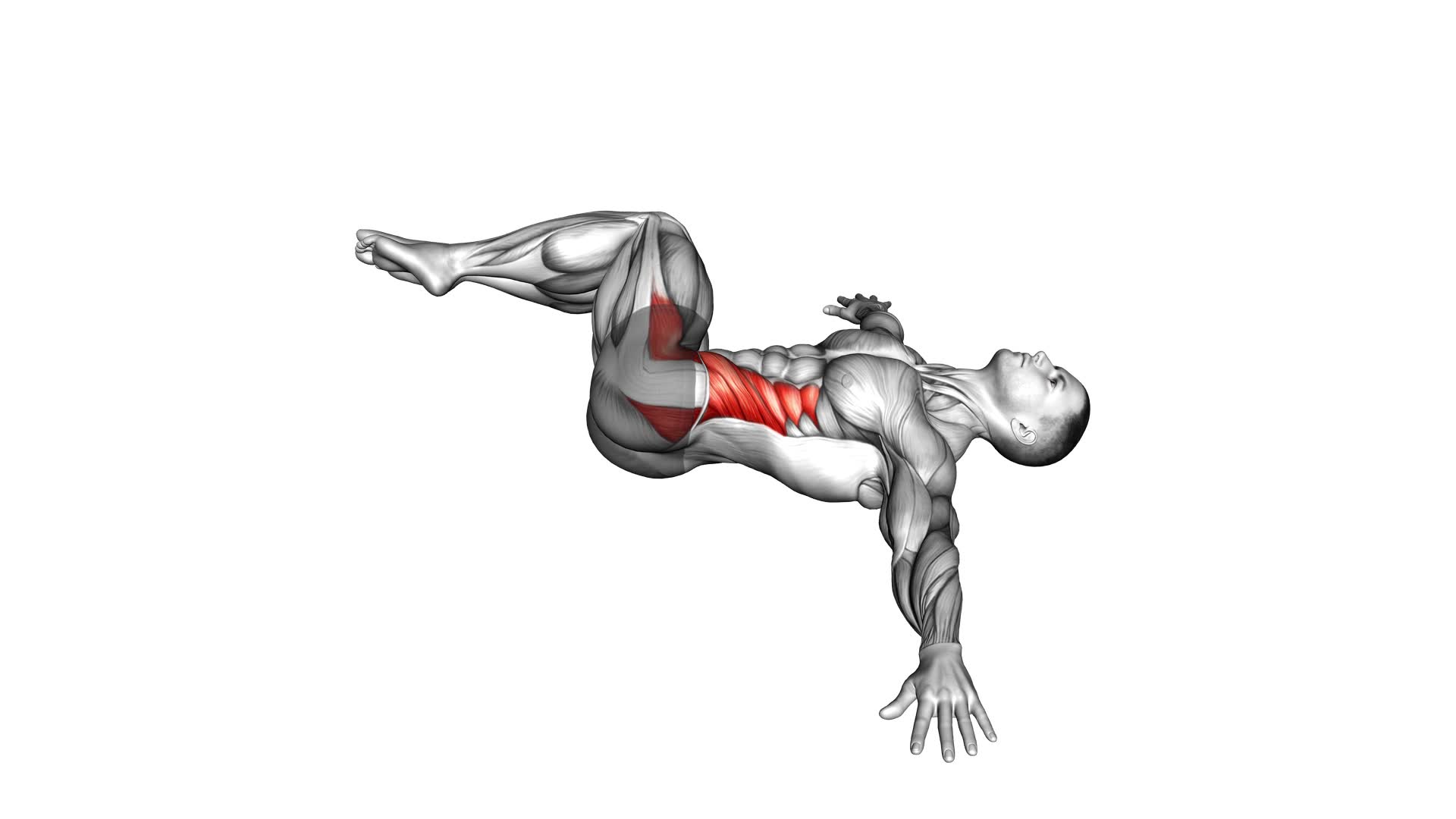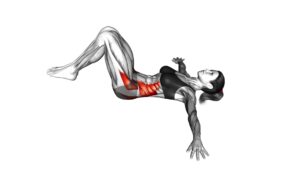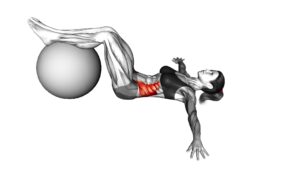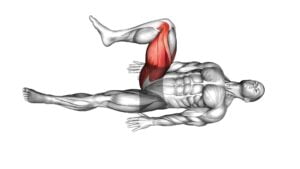Bent Knee Lying Twist (Male) – Video Exercise Guide & Tips

Are you looking to strengthen your core and improve flexibility?
Watch This Exercise Video
The Bent Knee Lying Twist is the perfect exercise for you.
This video exercise guide provides step-by-step instructions and helpful tips to ensure you perform the exercise correctly.
Whether you are a beginner or an experienced fitness enthusiast, there are modifications available to suit your fitness level.
Avoid common mistakes and maximize the effectiveness of this exercise with our expert advice.
Get ready to feel the burn and achieve your fitness goals.
Key Takeaways
- Improved spinal mobility and flexibility
- Activation and strengthening of core muscles
- Reduction in lower back pain
- Enhanced overall stability and balance
Benefits of the Bent Knee Lying Twist
Discover the benefits you can experience from practicing the Bent Knee Lying Twist. This exercise offers numerous health benefits and promotes muscle activation.
One of the key health benefits of the Bent Knee Lying Twist is improved spinal mobility. As you perform the twist, your spine goes through a gentle rotation, which helps to increase flexibility and reduce stiffness in the back. This can be particularly beneficial for individuals who spend long hours sitting or have sedentary lifestyles.
Additionally, the Bent Knee Lying Twist activates and strengthens the core muscles. As you twist, your abdominal muscles are engaged to stabilize and support the movement. This not only helps to tone and strengthen the core, but it also enhances overall stability and balance.
Furthermore, this exercise also targets the muscles of the hips and glutes. The twisting motion engages the muscles in these areas, helping to improve their strength and flexibility. This can be particularly advantageous for individuals who experience hip tightness or discomfort.
Incorporating the Bent Knee Lying Twist into your regular exercise routine can have significant benefits for your overall health and well-being. By improving spinal mobility, activating core muscles, and targeting the muscles of the hips and glutes, this exercise can contribute to a stronger, more flexible, and balanced body.
Proper Form and Technique
To perform the Bent Knee Lying Twist correctly, follow these steps:
- Lie on your back with your knees bent and feet flat on the floor.
- Keep your arms out to the sides, palms facing down.
- Slowly lower both knees to one side, aiming to touch the floor with your knees.
- Feel a gentle stretch in your lower back and hips.
- Hold this position for a few seconds.
- Return to the starting position.
- Repeat the exercise on the other side.
To target specific muscle groups, you can make variations to the Bent Knee Lying Twist:
- If you want to focus more on your obliques, place your hands behind your head.
- Twist your upper body towards the direction your knees are going.
- This will engage your oblique muscles more intensely.
Remember to maintain proper form throughout the exercise:
- Keep your core engaged.
- Avoid using momentum to swing your legs.
- Control the movement and focus on feeling the stretch in your muscles.
If you experience any pain or discomfort, stop the exercise and consult with a healthcare professional.
With consistent practice and proper form, the Bent Knee Lying Twist can help improve flexibility and strengthen your core and oblique muscles.
Modifications for Different Fitness Levels
For individuals of varying fitness levels, there are modifications available for the Bent Knee Lying Twist exercise. Whether you're a beginner looking to build strength or an advanced athlete aiming to challenge yourself further, these modifications will help you progress or regress the exercise to suit your fitness level.
Here are three options to consider:
- Progression: If you find the Bent Knee Lying Twist too easy, you can increase the challenge by straightening your legs instead of keeping them bent. This will engage your core and obliques to a greater extent, intensifying the workout.
- Regression: On the other hand, if you're just starting out or have limited mobility, you can modify the exercise by bending your knees more and reducing the range of motion. This will make it easier to perform the twist while still targeting your abdominal muscles effectively.
- Intermediate Option: For those in between, you can begin with the basic Bent Knee Lying Twist and gradually work towards straightening your legs over time. This allows for a gradual progression and helps you build strength and stability.
By adjusting the Bent Knee Lying Twist according to your fitness level, you can ensure that you're challenging yourself appropriately without risking injury or compromising form.
Now, let's move on to the next section and discuss common mistakes to avoid.
Common Mistakes to Avoid
Avoid these common mistakes when performing the Bent Knee Lying Twist exercise to ensure proper form and maximize the effectiveness of your workout.
One of the most common mistakes is improper alignment. It's essential to maintain proper alignment throughout the exercise to avoid strain and injury. Make sure to keep your spine straight and aligned with your neck. Avoid rounding your back or hunching your shoulders.
Another mistake to watch out for is using too much momentum. Instead of relying on momentum to twist your body, focus on engaging your core muscles and using controlled movements. This won't only target the intended muscles more effectively but also reduce the risk of injury.
Lastly, avoid rushing through the exercise. Take your time to perform each twist slowly and with control. This will allow you to engage your muscles fully and reap the benefits of the exercise.
Tips for Maximizing the Effectiveness of the Exercise
Maintain proper alignment and engage your core muscles to maximize the effectiveness of the Bent Knee Lying Twist exercise. Here are some tips to help you get the most out of this exercise:
- Focus on your form: Make sure your spine is aligned and your shoulders are relaxed throughout the movement. Keep your core engaged and avoid any jerky or sudden movements.
- Control your breathing: Breathe deeply and exhale as you twist your knees to the side. This will help you engage your core muscles more effectively and maintain stability.
- Gradually increase the intensity: Once you have mastered the basic form of the Bent Knee Lying Twist, you can try variations to challenge yourself further. For advanced users, you can extend your legs fully or add resistance by holding a dumbbell or medicine ball.
Maximizing results from the Bent Knee Lying Twist exercise requires proper form, controlled breathing, and gradually increasing the intensity. By incorporating these tips into your routine, you can target your core muscles more effectively and achieve better results.
Remember to listen to your body and adjust the intensity according to your fitness level.
Frequently Asked Questions
How Many Calories Does the Bent Knee Lying Twist Burn?
The Bent Knee Lying Twist is a great exercise for burning calories and aiding in weight loss. By engaging your core and twisting your torso, you activate multiple muscle groups, increasing your heart rate and energy expenditure.
While the exact number of calories burned can vary depending on factors such as weight and intensity, this exercise can be an effective addition to your fitness routine. Remember to consult with a professional to ensure proper form and technique.
Can the Bent Knee Lying Twist Help Reduce Belly Fat?
The Bent Knee Lying Twist is a popular exercise for toning your abs and obliques. It involves lying on your back with your knees bent and twisting your torso from side to side.
While this exercise can help strengthen your core muscles, it's important to note that it alone won't directly reduce belly fat. To achieve that, you'll need to combine the Bent Knee Lying Twist with a healthy diet and overall exercise routine.
Is the Bent Knee Lying Twist Safe for Individuals With Lower Back Pain?
The bent knee lying twist is a great exercise for overall back health. However, if you have lower back pain, there are some modifications you can make to ensure safety.
One modification is to keep your knees closer together and not let them drop too far to the side. This can help to alleviate strain on the lower back.
Remember to listen to your body and stop if you feel any pain or discomfort.
How Long Should I Hold the Bent Knee Lying Twist Position?
To ensure proper form in the bent knee lying twist, it's recommended to hold the position for about 20-30 seconds. This will allow your muscles to stretch and increase flexibility.
Beginners can modify the exercise by keeping their knees bent at a smaller angle and taking breaks as needed. Remember to listen to your body and adjust the duration accordingly.
Practice regularly for best results.
Can the Bent Knee Lying Twist Improve Flexibility in the Hips and Lower Back?
The Bent Knee Lying Twist exercise can indeed improve flexibility in your hips and lower back. By engaging in this exercise, you can work on increasing your hip mobility and strengthening your core muscles.
The twisting motion helps to stretch and release tension in these areas, promoting greater flexibility over time. Incorporating this exercise into your routine regularly can lead to improved overall mobility and a stronger, more resilient body.
Conclusion
In conclusion, the bent knee lying twist is a beneficial exercise that can help improve flexibility and strengthen the core muscles. By following proper form and technique, individuals of different fitness levels can safely perform this exercise.
It's important to avoid common mistakes and maximize the effectiveness of the exercise by incorporating tips such as engaging the core and breathing properly.
Incorporating the bent knee lying twist into your workout routine can contribute to overall fitness and well-being.

Author
Years ago, the spark of my life’s passion ignited in my mind the moment I stepped into the local gym for the first time. The inaugural bead of perspiration, the initial endeavor, the very first surge of endorphins, and a sense of pride that washed over me post-workout marked the beginning of my deep-seated interest in strength sports, fitness, and sports nutrition. This very curiosity blossomed rapidly into a profound fascination, propelling me to earn a Master’s degree in Physical Education from the Academy of Physical Education in Krakow, followed by a Sports Manager diploma from the Jagiellonian University. My journey of growth led me to gain more specialized qualifications, such as being a certified personal trainer with a focus on sports dietetics, a lifeguard, and an instructor for wellness and corrective gymnastics. Theoretical knowledge paired seamlessly with practical experience, reinforcing my belief that the transformation of individuals under my guidance was also a reflection of my personal growth. This belief holds true even today. Each day, I strive to push the boundaries and explore new realms. These realms gently elevate me to greater heights. The unique combination of passion for my field and the continuous quest for growth fuels my drive to break new ground.







